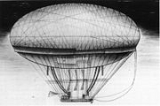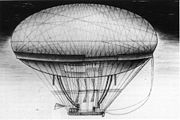
Jean Baptiste Meusnier
Encyclopedia

Tours
Tours is a city in central France, the capital of the Indre-et-Loire department.It is located on the lower reaches of the river Loire, between Orléans and the Atlantic coast. Touraine, the region around Tours, is known for its wines, the alleged perfection of its local spoken French, and for the...
, 19 June 1754 — le Pont de Cassel
Mainz-Kastel
Mainz-Kastel is a district administered by the city of Wiesbaden, Germany. Mainz-Kastel was formerly a district of the city of Mainz, until the public administration by the city of Wiesbaden was decided on August 10, 1945...
, near Mainz
Mainz
Mainz under the Holy Roman Empire, and previously was a Roman fort city which commanded the west bank of the Rhine and formed part of the northernmost frontier of the Roman Empire...
, 13 June 1793) was a French
France
The French Republic , The French Republic , The French Republic , (commonly known as France , is a unitary semi-presidential republic in Western Europe with several overseas territories and islands located on other continents and in the Indian, Pacific, and Atlantic oceans. Metropolitan France...
mathematician
Mathematician
A mathematician is a person whose primary area of study is the field of mathematics. Mathematicians are concerned with quantity, structure, space, and change....
, engineer
Engineer
An engineer is a professional practitioner of engineering, concerned with applying scientific knowledge, mathematics and ingenuity to develop solutions for technical problems. Engineers design materials, structures, machines and systems while considering the limitations imposed by practicality,...
and Revolutionary
French Revolution
The French Revolution , sometimes distinguished as the 'Great French Revolution' , was a period of radical social and political upheaval in France and Europe. The absolute monarchy that had ruled France for centuries collapsed in three years...
general. He is best known for Meusnier's theorem
Meusnier's theorem
In differential geometry, Meusnier's theorem states that all curves on a surface passing through a given point p and having the same tangent line at p also have the same normal curvature at p and their osculating circles form a sphere. The theorem was first announced by Jean Baptiste Meusnier in...
on the curvature of surfaces, which he formulated while he was at the École Royale du Génie (Royal School of Engineering). He also discovered the helicoid
Helicoid
The helicoid, after the plane and the catenoid, is the third minimal surface to be known. It was first discovered by Jean Baptiste Meusnier in 1776. Its name derives from its similarity to the helix: for every point on the helicoid there is a helix contained in the helicoid which passes through...
. He worked with Lavoisier on the decomposition of water and the evolution of hydrogen
Hydrogen
Hydrogen is the chemical element with atomic number 1. It is represented by the symbol H. With an average atomic weight of , hydrogen is the lightest and most abundant chemical element, constituting roughly 75% of the Universe's chemical elemental mass. Stars in the main sequence are mainly...
.
Dirigible balloon
Meusnier is sometimes portrayed as the inventor of the dirigible, because of an uncompleted project he conceived in 1784, not long after the first balloonBalloon
A balloon is an inflatable flexible bag filled with a gas, such as helium, hydrogen, nitrous oxide, oxygen, or air. Modern balloons can be made from materials such as rubber, latex, polychloroprene, or a nylon fabric, while some early balloons were made of dried animal bladders, such as the pig...
flights of the Montgolfiers, and presented to the Académie des Sciences (Academy of Sciences). This concerned an elliptical balloon (ballonet) 84 metres long, with a capacity of 1,700 cubic metres, powered by three propellors driven by 80 men. The basket, in the form of a boat, was suspended from the canopy on a system of three ropes.
Jacques Charles and Les Frères Robert
After their successful hydrogen balloon flights in 1783, professor Jacques CharlesJacques Charles
Jacques Alexandre César Charles was a French inventor, scientist, mathematician, and balloonist.Charles and the Robert brothers launched the world's first hydrogen-filled balloon in August 1783, then in December 1783, Charles and his co-pilot Nicolas-Louis Robert ascended to a height of about...
and the Robert brothers
Robert brothers
Les Frères Robert were two French brothers. Anne-Jean Robert , and Nicolas-Louis Robert , The brothers were the engineers who built the world's first hydrogen balloon for professor Jacques Charles; it flew from central Paris on...
built an elongated, steerable craft that followed Jean Baptiste Meusnier's proposals (1783–85) for a dirigible balloon. Their design incorporated Meusnier's internal ballonnet (air cells), a rudder, and a method of propulsion.
On July 15, 1784 the brothers flew for 45 minutes from Saint-Cloud
Saint-Cloud
Saint-Cloud is a commune in the western suburbs of Paris, France. It is located from the centre of Paris.Like other communes of the Hauts-de-Seine such as Marnes-la-Coquette, Neuilly-sur-Seine or Vaucresson, Saint-Cloud is one of the wealthiest cities in France, ranked 22nd out of the 36500 in...
to Meudon
Meudon
Meudon is a municipality in the southwestern suburbs of Paris, France. It is in the département of Hauts-de-Seine. It is located from the center of Paris.-Geography:...
with M. Collin-Hullin and Louis Philippe II, the Duke of Chartres
Louis Philippe II, Duke of Orléans
Louis Philippe Joseph d'Orléans commonly known as Philippe, was a member of a cadet branch of the House of Bourbon, the ruling dynasty of France. He actively supported the French Revolution and adopted the name Philippe Égalité, but was nonetheless guillotined during the Reign of Terror...
in their elongated balloon. Rather than 80 men it was fitted with oars for propulsion and direction, but they proved useless. The absence of a gas release valve also meant that the duke had to slash the ballonnet to prevent rupture when they reached an altitude of about 4,500 metres.
On September 19, 1784 the brothers and M. Collin-Hullin flew for 6 hours 40 minutes, covering 186 km from Paris to Beuvry
Beuvry
Beuvry is a commune in the Pas-de-Calais department in the Nord-Pas-de-Calais region of France.-Geography:A suburban town immediately southwest of Béthune, southwest of Lille, at the junction of the D945, D72 and N41 roads...
near Béthune
Béthune
Béthune is a city in northern France, sub-prefecture of the Pas-de-Calais department.-Geography:Béthune is located in the former province of Artois. It is situated South-East of Calais, West of Lille, and North of Paris.-Landmarks:...
. En route they passed over Saint-Just-en-Chaussée
Saint-Just-en-Chaussée
Saint-Just-en-Chaussée is a town in northern France. It is designated municipally as a commune within the département of Oise.-History:Its name refers to Saint Justus of Beauvais, who is said to have been martyred at this spot.-Notable people:...
and the region of Clermont de l’Oise
Clermont, Oise
Clermont is a small city in northern France. It is designated municipally as a commune within the département of Oise.-Main sights:* Church St Samson containing numerous Painting from the seventeenth century...
. This was the first flight over 100 km.
Giffard's dirigible
In 1852, sixty six years after Charles and the Robert brothers 'oar powered' dirigible, Henri GiffardHenri Giffard
Henri Giffard was a French engineer. In 1852 he invented the steam injector and the powered airship.-Career:Baptiste Henri Jacques Giffard was born in Paris in 1825...
's design for the first successful powered airship was inspired by Meusnier's ideas.

